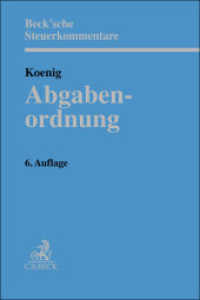- ホーム
- > 洋書
- > 英文書
- > Philosophy
Full Description
In recent years, developments in experimental philosophy have led many thinkers to reconsider their central assumptions and methods. It is not enough to speculate and introspect from the armchair-philosophers must subject their claims to scientific scrutiny, looking at evidence and in some cases conducting new empirical research. The Theory and Practice of Experimental Philosophy is an introduction and guide to the systematic collection and analysis of empirical data in academic philosophy.
This book serves two purposes: first, it examines the theory behind "x-phi," including its underlying motivations and the objections that have been leveled against it. Second, the book offers a practical guide for those interested in doing experimental philosophy, detailing how to design, implement, and analyze empirical studies. Thus, the book explains the reasoning behind x-phi and provides tools to help readers become experimental philosophers.
Contents
Figures and Tables
Acknowledgments
Introduction: An Anti-Manifesto
PART I: THEORY
Chapter 1: The New Experimental Philosophy
What Is Experimental Philosophy?
Experimental Philosophy of Experimental Philosophy
Summary and Suggestions for Further Reading
Chapter 2: Motivations and Categorizations
Philosophical Inquiry
The Wonderment Account
The Historical Contingency Account
The Normative Account
The Modal Account
The Rational Account
The Conceptual Account
A Classification Scheme
Non-Intuitional vs. Intuitional Experimental Philosophy
Intuitional Experimental Philosophy
The Evidential Approach
The Neutral Approach
Summary and Suggestions for Further Reading
Chapter 3: Programs and Examples
The Non-Intuitional Program
The Negative Program
Knowledge
Reference
The Positive Program
Compatibilism about Free Will
Playing Defense
The Cognitive Program
Sources of Moral Intuitions
Sources of Attributions of Intentionality
Sources of Attributions of Consciousness
The Descriptive Program
Summary and Suggestions for Further Reading
Chapter 4: Criticisms and Responses
The Mischaracterization Objection
Explaining Away Appeals to Intuitions
Against the Mischaracterization Objection's Empirical Claim
Against the Critical Inference
The Error Objection
Sosa's Version of the Error Objection
Kauppinen's Version of the Error Objection
Three Replies to the Error Objection
The Expertise Objection
The Expertise Objection and Intuitions about Reference
Four Replies to the Expertise Objection
Summary and Suggestions for Further Reading
PART II: PRACTICE
Chapter 5: How to Conduct Empirical Research in Philosophy
Empirical Inquiry and Statistical Inference
Experiments and Control
The Research Process
Summary and Suggestions for Further Reading
Chapter 6: Developing a Research Question
Formulating an Argument
Deriving a Hypothesis
Deciding on a Strategy
Goals
Type of Claim
Summary and Suggestions for Further Reading
Chapter 7: Determining the Research Design
Simple Designs and Factorial Designs
Between-Participants, Within-Participants, and Mixed Model Designs
Summary and Suggestions for Further Reading
Chapter 8: Advanced Research Designs
Pretests and Posttests
Blocking
Complete, Incomplete, and Fractional Factorial Designs
Counterbalancing
Summary and Suggestions for Further Reading
Chapter 9: Constructing an Instrument
Conversational Pragmatics
Types of Questions
Types of Variables
Summary and Suggestions for Further Reading
Chapter 10: A Brief Introduction to R
Getting Started with R
Naming and Retrieval
Reading Files
Loading Packages
Summary and Suggestions for Further Reading
Chapter 11: Conducting a Study
Pilot Testing and Institutional Approval
Sampling, Probably by Convenience
Data Visualization and Summary Statistics
Histograms
Means and Standard Deviations
Medians
Boxplots
Summary and Suggestions for Further Reading
Chapter 12: Analyzing Estimation Claims
Parametric Estimation
Example: Drawing Marbles from a Bucket
Confidence Intervals for Population Proportions
Confidence Intervals for Population Means
Non-Parametric Estimation
Confidence Intervals for Population Proportions
The Wilcoxon Procedure
Bootstrap Resampling
Bayesian Estimation
Summary and Suggestions for Further Reading
Chapter 13: Analyzing Comparison Claims
Parametric Comparison
Comparing a Location Parameter to a Fixed Value
Comparing Multiple Location Parameters
Effect Size and Statistical Power
Non-Parametric Comparison
Comparing Population Proportions
The Wilcoxon Procedure
Bootstrap Resampling
Bayesian Comparison
A Bayesian Alternative to the t-test
Bayesian Power Calculations
Summary and Suggestions for Further Reading
Chapter 14: Analyzing Relation Claims
Simple Linear Regression
Diagnostics for Simple Linear Regression
One-Way Analysis of Variance
Logistic Regression and Ordered Logistic Regression
Multiple Regression and Advanced Experimental Designs
An Introduction to Causal Search
Summary and Suggestions for Further Reading
References
Index








